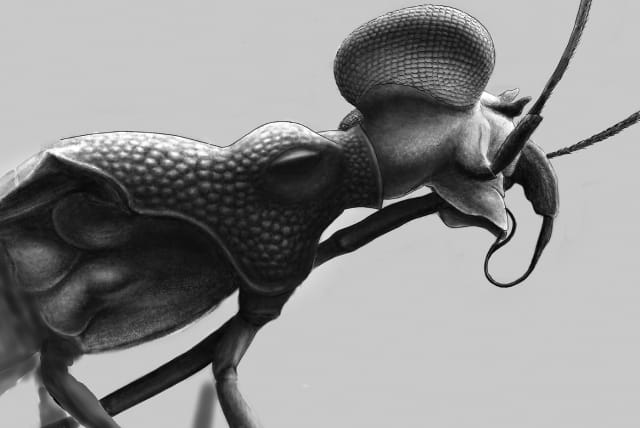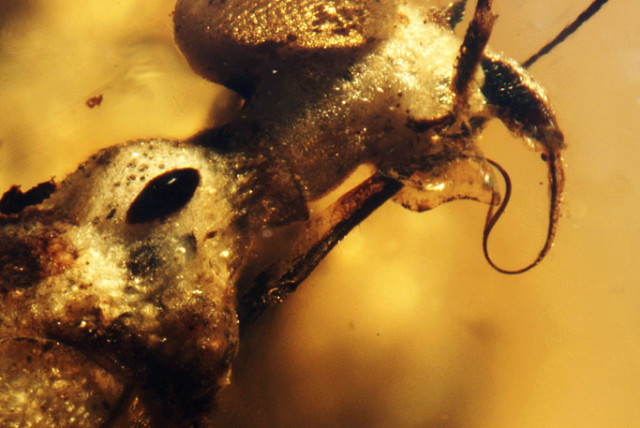A 99-million-year-old bug that lived in Myanmar discovered by Israeli researchers

Compared to the species already known to science, the new features of the bug include unique colors and shapes that the researchers believe were used as a deterrent against predators.
A new species of bug unknown to science until now and which lived about 99 million years ago during the time of the dinosaurs has been discovered in amber that came from Myanmar (formerly Burma) by Hebrew University of Jerusalem (HU) scientists.
It has now been described for the first time by Dolev Fabrikant of HU’s Alexander Silberman Institute of Life Science and Dr. Tanya (Tatiana) Novoselski, director of the collection of bugs at The Steinhardt Museum of Natural History, Israel National Center for Biodiversity Studies at Tel Aviv University
Among its features, compared to the species already known to science, are its unique colors and shapes that the researchers believe were used as a deterrent against predators. The researchers also noted that the very fact that the colors of the new bug have been preserved throughout the years is no less surprising.
The insect, which was described as a new genus and species, was found in a piece of amber that was exceptionally preserved. This allowed the team to study its morphology in detail and identify that it has a number of unique characteristics that distinguish it from the other insects known from amber – huge eyes that occupy most of the head and very colorful.
Ancient insects preserved in amber often have a yellowish-brown, pale, and uniform color while sharp and clear colors are rarer. The name that can be given to the bug, which refers to its coloring is Miropictopallium coloradmonens (painted cloak).
The new study has just been published in the Israel Journal of Entomology under the title “A peculiar large-eyed aposematic bug Miropictopallium coloradmonens from mid-Cretaceous Kachin amber.”
The significance of the discovery
The discovery helps entomologists (insect experts) and archaeologists to better understand what the living environment and biodiversity looked like in the same area during the time of the dinosaurs 99 million years ago, and the role of various items in nature, and to examine which of the species survived, evolved, or became extinct throughout the millions of years.
Also, knowing the ancient biodiversity helps researchers to better anticipate and evaluate the resistance and survival of species in the future and the effects of global warming and other variables on many species.
The amber that was part of the current study, and on which the new bug was discovered, came to the researchers as part of an auction and is typical of the types of amber that are sold in markets in the region of what is today Myanmar. Types of insects – members of the family to which the new species belongs – are also documented in many areas and even in our area in Lebanon, which raises the question of whether the newly identified bug was also a local species in our area in the past.
Many of the insects that lived during this time became extinct as a result of climatic changes and competition with other species.
“The newly discovered insect contributes to the understanding of the world today because it adds knowledge about an important turning point in the history of life on land,” said Fabricant, an HU graduate student. “The period of its origin is characterized by an unprecedented biological diversity and the beginning of the formation of modern ecosystems in their composition.”
Novoselski, director of the bug collection at the Steinhardt Museum, added, “a new insect and fascinating discovery that sheds light on the evolution of bugs and provides new insights into the diversity of life in the middle of the Cretaceous. The diversity and development of insects during this period also highlights the importance of amber fossils for paleontological research.”
Jerusalem Post Store
`; document.getElementById("linkPremium").innerHTML = cont; var divWithLink = document.getElementById("premium-link"); if (divWithLink !== null && divWithLink !== 'undefined') { divWithLink.style.border = "solid 1px #cb0f3e"; divWithLink.style.textAlign = "center"; divWithLink.style.marginBottom = "15px"; divWithLink.style.marginTop = "15px"; divWithLink.style.width = "100%"; divWithLink.style.backgroundColor = "#122952"; divWithLink.style.color = "#ffffff"; divWithLink.style.lineHeight = "1.5"; } } (function (v, i) { });

